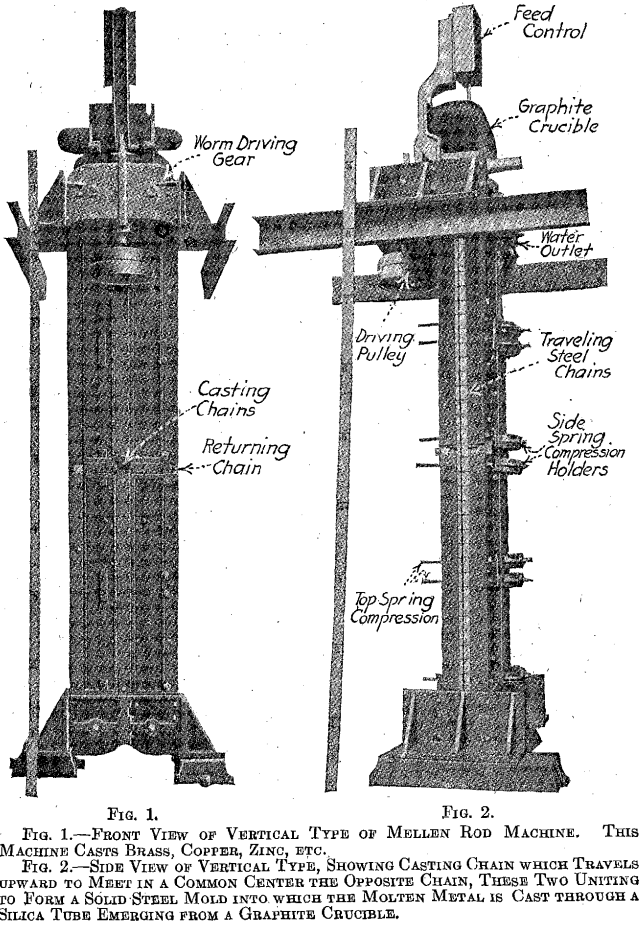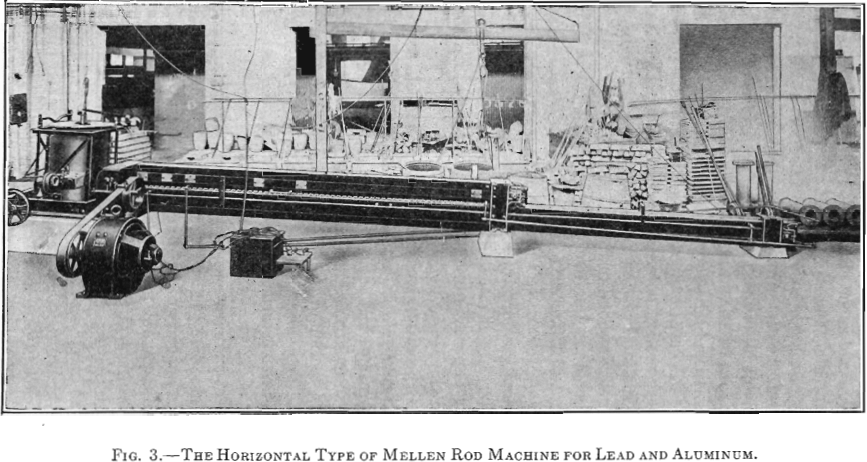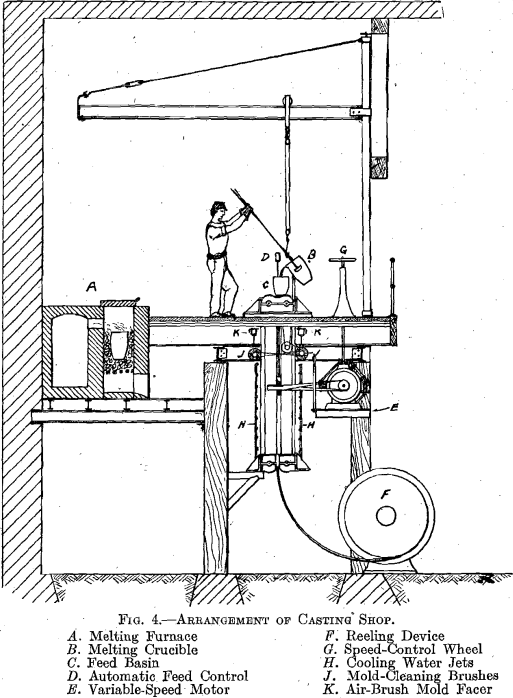In view of the circumstance that very few important changes have been made within the last 15 or 20 years in the equipment of rod and wire mills, the description of a new process introduced by Grenville Mellen, of Llewellyn Park, N. J., to take the place of the present laborious system of producing rods of lead, zinc, brass, copper, aluminum, etc., may be interesting to members of the Institute. This new process consists in the production of cast rods at one operation in a small continuous casting machine.
The hot liquid metal is transferred from the melting crucibles directly into an endless chain of mold blocks in the machine, where solidification takes place, and the rod comes out continuously in a solid form at one end as long as the molten metal is supplied. The operation of these mold blocks so as to produce a solid rod of uniform structure constitutes an important part of Mr. Mellen’s invention.
The machine (Figs. 1 and 2), 12 ft. in height over all, 2 by 3 ft. in horizontal cross-sectional area, and 6,000 lb. in weight, has a framework of cast iron, holding in position two endless chains of mold blocks, which are made in sections and join in center alignment. The mold orifice is made up of these mold sections, into which the liquid metal flows.
The molding chains are composed of steel blocks, grooved on one face to form the molding cavity, and linked together with flexible joints. Each block is carried on four rollers which guide the chain around the end sprockets and carry it in its course through the machine.
The accuracy of alignment requisite to the production of a perfect rod in the mold groove formed by these sections is secured by careful machine work, and by building the four ways, down which the alignment takes place, so that two of the sides are fixed permanently, while the opposite sides are held to their position by spring pressure. The guides carrying the molds, while in casting position, are water-cooled square tubes.
The length of this machine is somewhat indeterminate. A certain amount of both time and cooling surface is required to solidify the metal in the mold; and one may either use a long molding chain and run it fast, or a shorter chain and run it correspondingly slower. We have found,

however, that with 8 ft. length between centers for the chains a casting speed of 25 ft. per minute for 7/8-in,. brass rod will not cause the molding blocks to rise in temperature above 450° F.
Experiments have shown that in the casting of bronze mixtures, the pair of molding blocks should have about six times as much sectional area as the cast rod, to allow a reasonable temperature difference for the rapid removal of the heat.
The first machines designed for this process of continuous casting were vertical; but the desire of practical rod-mill men to operate with the molding groove horizontal led Mr. Mellen to spend considerable time in experimental improvements of the mechanical details, in order to secure a maximum efficiency for the horizontal machine. In this attempt, numerous troubles and intricate problems were encountered. The machine would always cast rods; but its successful operation in a horizontal position required more skill than that of an ordinary laborer. After much experiment the axis was first made slightly inclined; but finally the vertical position was readopted; and in this form one laborer, with a little preliminary instruction, can manage the machine without difficulty.
The chief hindrances to horizontal operation were; (1) the difficulty of completely filling the molds, and (2) the circumstance that, in working horizontally, the lower chain did the greater part of the work and became after a time excessively heated, while the upper chain remained relatively cool. This caused an irregular structure both in the cast rod and in the drawn product resulting therefrom; and as a result the required strength tests were not satisfactory.
In the vertical arrangement these difficulties automatically cured themselves since the metal completely filled the mold, with uniform contact all round, thus causing each portion of the chain to do its work, and giving a symmetrical structure to both rod and resulting wire.
The importance of making all of the chain work all the time is shown by the fact that in the vertical type of machine the chain can be considerably shortened, and yet the machine is capable of running at higher speed than when arranged horizontally. This vertical arrangement, however, necessitates operation on two levels.
The flow of metal into the machine is controlled by an electrically operated automatic device, which adjusts the feed to the speed at which the machine is operated. If for any reason the machine should stop the flow would be automatically shut off.
A safety device is incorporated into the drive, so that if any foreign material clogs the chain a safety pin is sheared, thus protecting the mechanism from injury.
The rods are delivered from the machine immediately to the die of the bull block, where they are drawn down to suit particular orders.
This new method of manufacturing rods does away with the following steps of the old system:
- Casting the wire bar.
- Handling the wire bar from the molds.

- Rehandling the wire bar to and from the reheating furnace.
- Reheating the wire bar.
- Rolling the wire bar.
It also eliminates the loss from oxide scaling during heating and rolling. These economies involve, of course, the saving of much capital, now invested in heating furnaces, rolling mills, power plants, land, and buildings. Since the power required to run this machine is only about 5 hp., the cost of large engines, boilers, coal bins, etc., is practically done away with.
Another advantage is the elimination of danger to human life. The apparatus is completely enclosed, so that the operator is protected from injury. Finally, the labor cost of this process is but 5 per cent, of that of the old method, the caster being the only workman required.
A later development of this continuous casting machine is the machine (Fig. 3) casting rods of lead and soft-metal alloys, ¼, in. and upward in diameter. This is the first step in the manufacture of shrapnel bullets; and the machine will cast per hour enough lead rod for more than 200,000 bullets. The only motive power required is that which is necessary for overcoming the friction resisting the motion of the traveling mold chains, which is in the neighborhood of from 2 to 3 hp.
This lead machine is practically the same as that used for brass with the exception that it is operated in a horizontal plane. Also, the horsepower is slightly decreased, and the machine is a few feet longer.
In two drawings, the area of brass rod is reduced about 27 per cent, without annealing; but it must be realized that the area reduction and pull are variables depending upon the mixture cast. An 80-hp. motor is used in handling the 1¼-in. rod.
The continuous casting machine is also applicable to the production of aluminum and zinc rod. Aluminum rods are produced with diameters ranging from ¾ in. upward.
The casting-shop arrangement is shown by Fig. 4. This may be considered a cross-section of the shop with a long line of melting furnaces in parallel to the one shown, all of which supply metal to one casting machine. The melting furnace A is one of 40, the crucibles of which have a capacity of 220 lb. each with six heats per 10 hr. All of these are considered just sufficient, when operating at full capacity, to satisfy one casting machine in 10 hr. The feed basin C consists of a graphite crucible and has a capacity of 194 lb. The automatic feed-control device D consists of a solenoid magnet operating in a battery circuit, one terminal of which is grounded on the machine and the other terminal attached to a graphite point projecting into the mold orifice. When the metal in the mold rises to this graphite terminal it closes this circuit and the magnet is energized. This magnet operates upon a beam to partly close a carbon valve controlling the inlet of metal into the mold bore. When the rod that is being cast into the molds is carried below this graphite tip, the circuit is broken and the valve lifts, allowing more metal to enter the machine.
The variable-speed motor E is used to drive the machine. The variation in speed is necessary to enable the machine to be operated on different brass mixtures, some of which flow more freely than others. This speed is suitably adjusted by the operator at the speed-control wheel G.
The reeling device F takes the rod delivered from the machine and rolls it into bundles to facilitate its further handling. The cooling water

jets H are a series of pipes arranged opposite the faces of the returning molds through which a series of streams of water are played directly upon the mold faces for cooling purposes. These streams are not turned on until the molds have reached a temperature sufficient to vaporize this water. In practice the molds appear perfectly dry a few inches above the uppermost jet. Above these water jets are noted the mold-cleaning brushes J. These, which are made of steel, revolve by a chain mechanism and serve to clean any deposit from the surface of the mold and prepare it to receive the necessary facing, which is applied in liquid form by means of air brushes K.
The machine’s operating cost is less than 30c. per ton of molten metal into the form of rods. U. S, and foreign patents have been secured for this invention.

